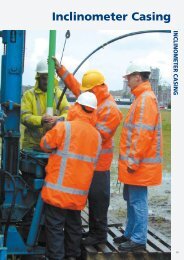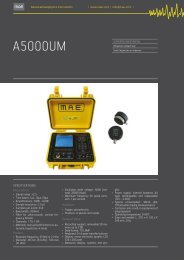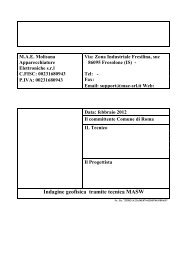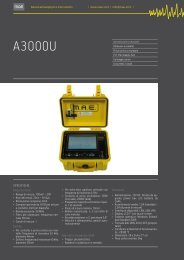Untitled
Untitled
Untitled
Create successful ePaper yourself
Turn your PDF publications into a flip-book with our unique Google optimized e-Paper software.
› Mae 9<br />
› SONIC TEST ON MASONRY<br />
The principle of the sonic tests on masonry<br />
is the same as principle of ultrasound<br />
tests on concrete. The only difference<br />
is the method to produce the<br />
longitudinal elastic wave used for the<br />
measurement: a hammer is used instead<br />
of an ultra-sonic pulse. The frequencies<br />
thus produced (a few hundreds<br />
of Hz), lower than those of the<br />
ultra-sounds (a few tens of KHz) are<br />
able to also cross scarcely compact<br />
masonry walls, such as brick-faced<br />
or brick walls, thus allowing to evaluate<br />
the conservation state, through<br />
the speed and/or mitigation values of<br />
the wave produced. This type of test<br />
can also be applied on concrete structures,<br />
which sizes do not allow to use<br />
ultra-sounds, because these can no<br />
longer be measured at a few metres<br />
from the source. The sonic tests give<br />
less accurate values compared to the<br />
tests with ultra-sounds, but they can<br />
be performed also on scarcely compact<br />
materials and/or at a distance of<br />
a few metres.<br />
› PILE INTEGRITY TEST<br />
The sonic echo test is a survey method<br />
consisting in the measurement<br />
of the reflection speed of compression<br />
waves, to assess the integrity of<br />
a pole. The method was conceived in<br />
Holland during the 70s, as instrument<br />
to check the quality of pre-fabricated<br />
foundation poles in concrete, extensively<br />
used in that country. Due to the<br />
regularity of the surfaces of the prefabricated<br />
poles, the sonic echo test<br />
could be used with a high level of reliability.<br />
For this type of test, a compression<br />
wave is propagated until the base<br />
of the pole and is reflected towards its<br />
head. The compression wave is generated<br />
with an impact on the pole head<br />
and the signal recorded by a geophone<br />
is displayed in a graph in real time. If<br />
discontinuities are present in the pole<br />
such as variations of the section or<br />
cracks, these cause reflections. If the<br />
discontinuities are fairly significant,<br />
such as for example a complete fracture<br />
of the concrete, these cause an<br />
almost complete fracture, thus preventing<br />
to detect the base of the pole.<br />
In order to execute the test properly,<br />
the pole head must be accessed. The<br />
geophone is placed on the concrete<br />
surfaced, properly prepared, through<br />
a coupling material and by placing<br />
on top a load of a few kg. When the<br />
head of the pole is hit in a selected<br />
point, the impact enables the acquisition<br />
of the signal produced by the geophone,<br />
which is shown immediately on<br />
the screen. In order to eliminate the<br />
background noise caused from the<br />
construction site activities, the acquisition<br />
can be repeated a few times to<br />
calculate the averages.









